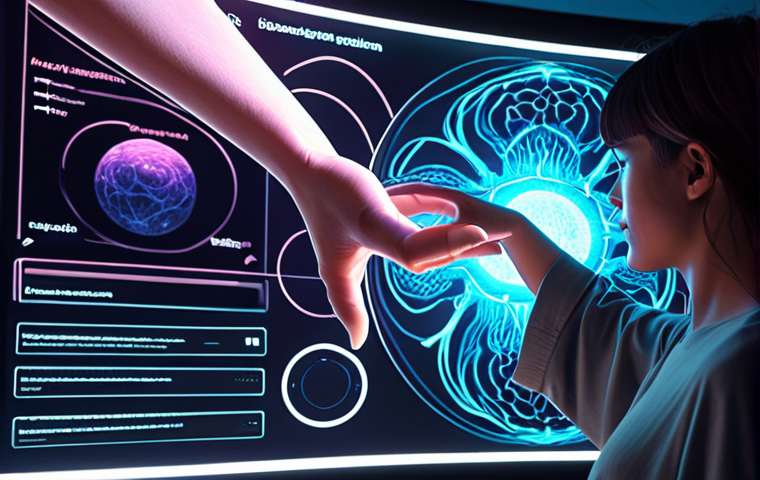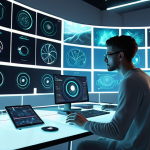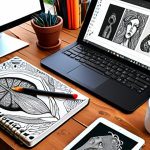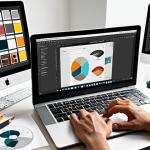The ink was barely dry on my Digital Graphics Specialist certification when a wave of excitement—and pure terror—washed over me. I’d spent months mastering everything from Photoshop layers to 3D modeling fundamentals, picturing myself landing that dream job.
But then reality hit: how do you actually *get* hired in such a competitive, fast-evolving field? I remember feeling completely lost, scrolling through endless job boards, wondering if my skills were even relevant with AI-powered design tools emerging or the ever-increasing demand for niche skills like real-time rendering and AR/VR experiences.
My journey from certified hopeful to actually *working* in the digital media space was anything but straightforward, filled with late-night portfolio tweaks and networking events that felt more like speed-dating for creatives.
Despite the rapid changes and the constant buzz about new technologies, what truly matters is a solid foundation, adaptable skills, and a genuine passion for creation.
Having navigated those initial hurdles and seen firsthand how the industry is shifting, I’ve gathered some insights that I genuinely wish someone had told me back then.
What kind of roles are out there today, how do you stand out from the crowd, and what does the future truly hold for digital artists? Let’s find out exactly.
Navigating the Shifting Sands of Digital Art Careers

I remember sitting at my desk, feeling utterly overwhelmed by the sheer volume of “digital artist” roles listed online. It felt like everyone wanted something slightly different, and the job titles themselves were a language all their own.
Was I a UI/UX designer? A motion graphics artist? A 3D generalist?
The truth is, the digital media industry is incredibly diverse, constantly evolving, and much broader than just a few well-known roles. What I learned the hard way is that specialization, paired with a solid understanding of fundamental design principles, is often the key to unlocking real opportunities.
It’s not enough to be just “good at Photoshop” anymore; employers are looking for individuals who can fill very specific needs, whether that’s creating immersive virtual reality environments or developing sleek, intuitive app interfaces.
This shift demands a more focused approach from job seekers, moving away from a generalist mindset to one that highlights a unique, valuable skill set.
The beauty of it, though, is that once you identify your niche, the path forward becomes remarkably clearer, allowing you to tailor your portfolio and networking efforts more effectively.
1. Deconstructing the Digital Design Ecosystem
Understanding the different branches of digital design is your first step. When I first started, I thought “graphic designer” covered everything. Oh, how naive I was!
Today, you have specialized roles like Character Modeler, Environment Artist, Technical Artist, UI/UX Designer, Motion Graphics Animator, VFX Artist, and even roles like Digital Sculptor for game development or product design.
Each of these requires a distinct skill set and workflow. For instance, a UI/UX designer focuses on user experience and interface aesthetics, demanding strong empathy and problem-solving skills, whereas a 3D animator brings static models to life, requiring a deep understanding of movement, weight, and character performance.
My personal experience navigating this maze taught me that truly appreciating the nuances of each role not only helps you identify where you fit but also reveals adjacent opportunities you might not have considered initially.
2. Identifying Your Core Competencies and Passions
This is where self-reflection truly pays off. After my initial job search frustrations, I sat down and made a list: what did I genuinely enjoy doing? What tasks felt less like work and more like play?
For me, it was the storytelling aspect of motion graphics and the intricate details of 3D modeling. Once I identified those passions, I started aligning my skills with specific roles.
If you love precision and problem-solving, perhaps UI/UX or even technical art might be your calling. If you’re drawn to narratives and bringing characters to life, animation or concept art could be perfect.
Don’t chase trends just because they’re popular; dig deep into what truly excites you. This authentic connection to your craft will shine through in your portfolio and interviews, making you a much more compelling candidate than someone merely following the hype.
It’s about finding the intersection of what you’re good at, what you enjoy, and what the market needs.
Crafting a Portfolio That Screams “Hire Me!”
I can’t stress this enough: your portfolio is your golden ticket. Forget fancy resumes that no one reads; employers in digital media want to see what you can *do*.
My first portfolio was a mess – a jumble of school projects, personal experiments, and anything else I thought looked remotely “artsy.” It was generic, unfocused, and frankly, quite forgettable.
I remember sending it out and getting absolutely no responses, which was crushing. It took countless hours of refinement, countless online critiques, and a painful amount of self-doubt to understand that a great portfolio isn’t just a collection of your work; it’s a curated narrative that tells your story, showcases your specific skills, and proves you can solve problems relevant to the roles you’re applying for.
It should be a living, breathing testament to your evolving capabilities, always showcasing your absolute best and most relevant pieces.
1. Quality Over Quantity: The Power of a Curated Collection
This was a huge turning point for me. I used to think more projects meant more impressive. Wrong.
Employers spend mere seconds glancing at a portfolio. If your best work is buried under mediocre pieces, they’ll never see it. My advice?
Choose your absolute top 3-5 projects that are perfectly polished and directly relevant to the types of jobs you want. If you’re aiming for a UI designer role, don’t fill your portfolio with character illustrations, no matter how good they are.
Each piece should demonstrate a specific skill or problem-solving process. For example, if I was applying for a motion graphics role, I’d ensure my reels were short, punchy, and highlighted my strongest animation, compositing, and storytelling abilities, clearly indicating my role in each project.
2. Showcasing Your Process, Not Just the Polish
When I started getting feedback from industry pros, a common theme emerged: they wanted to see my thought process. How did I arrive at that final design?
What challenges did I face? What iterations did I go through? Adding case studies, mood boards, sketches, wireframes, and even breakdown videos transformed my portfolio.
It showed that I wasn’t just someone who could push buttons in software, but a thoughtful problem-solver. For a 3D modeling project, I’d include wireframes, texture maps, and perhaps even a brief explanation of my poly-count optimization.
This transparency builds trust and demonstrates a deeper understanding of your craft. It shows you’re not just a technician but a true creative professional.
Beyond Software: The Underrated Soft Skills You Need
When I was fresh out of my program, I believed mastering software like Maya or After Effects was 90% of the battle. I spent endless nights perfecting my polygon modeling and mastering intricate keyframe animations.
While technical prowess is undoubtedly crucial, I quickly learned that it’s only half the story. I vividly recall a project where my technical skills were top-notch, but my inability to clearly communicate with the project manager led to massive revisions and missed deadlines.
That painful experience taught me a profound lesson: soft skills are not just “nice-to-haves”; they are absolutely essential for survival and growth in the digital media world.
Employers are actively looking for team players who can not only produce stunning visuals but also integrate seamlessly into a collaborative environment.
1. Communication is King: Articulating Your Vision and Taking Feedback
The ability to articulate your ideas clearly and concisely, whether to a client, a project manager, or a fellow artist, is paramount. I’ve seen incredibly talented artists struggle simply because they couldn’t explain their creative decisions or effectively receive constructive criticism.
It’s a two-way street: you need to be able to present your vision compellingly, and equally important, you must be able to listen actively, understand feedback, and integrate it without ego.
Early in my career, I’d sometimes get defensive about my work. Learning to detach from my creations and view feedback as an opportunity for growth, rather than a personal attack, revolutionized my workflow and my relationships with colleagues.
My best advice here is to practice explaining your work out loud, even to yourself, and actively seek constructive criticism from peers.
2. Adaptability and Problem-Solving: Embracing the Unexpected
The digital media landscape is a constant state of flux. New software, new techniques, and new challenges emerge daily. If you’re not adaptable, you’ll quickly become obsolete.
I’ve personally experienced projects where the entire scope changed overnight, or a crucial piece of software had an unexpected bug. My ability to pivot, learn new tools on the fly, and troubleshoot creative problems became far more valuable than my initial mastery of any single program.
Employers aren’t just looking for someone who knows how to use a specific tool; they’re looking for resilient problem-solvers who can navigate uncertainty and find innovative solutions.
This often means being comfortable with discomfort, embracing failure as a learning opportunity, and maintaining a curious, open mindset.
Networking: Your Secret Weapon in a Digital World
Honestly, the thought of networking used to fill me with dread. The idea of walking into a room full of strangers, trying to “sell” myself, felt incredibly awkward and unnatural.
I preferred to just hide behind my computer screen and let my portfolio speak for itself. Big mistake. I quickly realized that many of the best opportunities in the digital media industry aren’t advertised; they come through word-of-mouth, referrals, and personal connections.
My first freelance gig came not from a job board, but from a casual conversation at a local design meetup. That experience was a powerful wake-up call, showing me that authentic connections, built on genuine interest and mutual respect, are far more effective than any cold application.
Networking isn’t about collecting business cards; it’s about building relationships.
1. Online and Offline Strategies: Building Your Circle
In today’s world, networking happens everywhere. Online platforms like LinkedIn, Behance, and ArtStation are excellent for connecting with industry professionals and showcasing your work.
I make it a point to regularly engage with posts, share insights, and comment thoughtfully on others’ projects. But don’t underestimate the power of in-person events: local meetups, conferences, workshops, and even university career fairs.
I remember attending a small, local animation festival where I struck up a conversation with someone who ended up becoming a mentor and, eventually, a collaborator on several paid projects.
These face-to-face interactions often lead to deeper, more meaningful connections than purely digital ones.
2. Giving More Than You Take: The Reciprocal Nature of Networking
My biggest shift in perspective came when I stopped viewing networking as “what can this person do for me?” and started asking, “how can I genuinely connect with this person and perhaps offer value?” This might mean sharing an interesting article, offering a helpful tip, or simply being a supportive peer.
When I started reaching out to people not with a job request, but with an open question about their experience or offering to share a resource, I found responses were much warmer and more frequent.
This genuine interest builds trust and rapport. People are far more likely to remember and help someone who has demonstrated a willingness to contribute, rather than just solicit.
Remember, every successful professional had help along the way, and they often appreciate the opportunity to pay it forward.
Embracing AI: Your Co-Pilot, Not Your Replacement
When AI-powered design tools started making serious waves, I’ll admit, a cold shiver ran down my spine. Was all my hard-earned skill suddenly obsolete?
Would a machine just churn out designs faster and cheaper than I ever could? This initial fear, I’ve realized, was completely misplaced. What I’ve seen firsthand is that AI isn’t replacing digital artists; it’s augmenting our capabilities, automating tedious tasks, and opening up entirely new creative avenues.
It’s like when Photoshop first came out – traditional artists didn’t vanish, they simply evolved their craft. The key is to see AI not as a threat, but as a powerful co-pilot, a new set of brushes in your digital toolkit.
1. Leveraging AI for Efficiency and Ideation
I now regularly use AI tools in my workflow. For instance, AI-powered image generation tools can quickly create mood boards or explore diverse visual styles in minutes, saving hours of manual searching.
AI can assist with upscaling images, generating variations of existing designs, or even creating basic 3D models from text prompts. I’ve personally used AI for quick prototyping of UI layouts, allowing me to iterate on ideas at lightning speed before diving into the detailed design.
This frees up my time to focus on the truly creative and strategic aspects of a project – the problem-solving, the storytelling, and the emotional connection that only a human can bring.
It’s about working smarter, not necessarily harder.
2. The Human Touch: Where Creativity and Empathy Reign Supreme
While AI excels at tasks that involve patterns, data, and computation, it still lacks genuine creativity, intuition, and emotional intelligence. AI can generate a thousand variations of a logo, but it can’t understand the subtle nuances of a brand’s ethos or the emotional resonance needed to connect with a human audience.
It can’t feel the frustration of a user struggling with an interface, nor can it truly empathize with the client’s vision. My experience shows that the future of digital art lies in this symbiotic relationship: AI handles the repetitive, technical aspects, while humans bring the strategic thinking, the artistic vision, the empathy, and the unique storytelling that makes a design truly impactful.
This is where our value as digital artists will continue to grow exponentially.
| Role Category | Description & Typical Tasks | Core Software & Skills | Market Outlook |
|---|---|---|---|
| UI/UX Designer | Focuses on user experience and interface design for apps, websites, software. Tasks include wireframing, prototyping, user testing, interaction design. | Figma, Adobe XD, Sketch, User Research, Prototyping, Information Architecture. | High demand, especially for mobile and web applications. |
| 3D Artist (Generalist/Specialized) | Creates 3D models, textures, animations for games, film, VR/AR, product visualization. Specializations include modeling, rigging, animation, lighting, texturing. | Maya, Blender, ZBrush, Substance Painter, Unreal Engine/Unity, Sculpting, Topology. | Steady demand, particularly in gaming, metaverse, and industrial design. |
| Motion Graphics Artist | Creates animated titles, logos, explainers, and visual effects for video, broadcast, and digital content. Blends design with animation. | After Effects, Cinema 4D, Illustrator, Photoshop, Keyframe Animation, Compositing. | Strong demand in advertising, social media, and digital storytelling. |
| VFX Artist/Compositor | Develops visual effects (explosions, creatures, environments) for film, TV, and commercials. Integrates live-action footage with CGI. | Nuke, Houdini, After Effects, Mocha, Green Screen Keying, Tracking, Rotoscoping. | Consistent demand in film and high-end commercial production. |
| Game Artist (Concept/Environment) | Designs characters, environments, props, and overall visual style for video games. Can be 2D or 3D, often working closely with game designers. | Photoshop, ZBrush, Blender, Unreal Engine/Unity, Concept Art, Environment Design, Texturing. | Very high demand, evolving with game engine advancements and indie scene growth. |
Future-Proofing Your Digital Design Career
The one constant in digital media is change. What’s cutting-edge today might be commonplace tomorrow, or even obsolete. I remember investing heavily in learning a specific software feature, only for the entire tool to be superseded by something else a few months later.
It was disheartening, but it taught me a vital lesson: rigid adherence to current trends or tools is a recipe for career stagnation. The real secret to a long and thriving career isn’t about mastering one specific program for life; it’s about cultivating a mindset of continuous learning, embracing new technologies, and understanding the foundational principles that transcend any single software.
This proactive approach ensures you remain relevant and valuable in an ever-shifting landscape.
1. The Power of Continuous Learning: Staying Ahead of the Curve
Never stop learning. This isn’t just a cliché; it’s a survival strategy. Whether it’s enrolling in an online course, attending industry webinars, reading trade publications, or simply dedicating an hour each week to experimentation with new features in your software, consistent learning is non-negotiable.
I personally subscribe to several industry newsletters and follow key innovators on social media to keep my finger on the pulse. I also dedicate specific time to personal projects that force me to learn new techniques or tools I wouldn’t use in my day-to-day work.
This proactive approach to skill development not only keeps your portfolio fresh but also makes you a more versatile and attractive candidate for future opportunities.
2. Mastering Fundamentals and Cross-Disciplinary Skills
While new tools emerge, the core principles of design – composition, color theory, typography, storytelling, problem-solving, and visual hierarchy – remain timeless.
These fundamentals are transferable across any medium or software. My advice? Invest deeply in understanding these core tenets.
Beyond that, consider broadening your horizons with cross-disciplinary skills. For example, a 3D artist who understands basic coding or scripting for automation is incredibly valuable.
A UI/UX designer with a grasp of marketing principles can make more impactful design decisions. This hybridization of skills creates a unique value proposition, making you less susceptible to the ebb and flow of single-skill demand.
The Monetization Mindset: Diversifying Your Creative Income
When I first started, my focus was solely on landing a full-time job. I pictured a steady paycheck and benefits, and that was the entire dream. While a stable role is fantastic, what I’ve discovered over the years is that relying on a single income stream in a rapidly changing industry can be precarious.
The digital landscape offers an unprecedented number of ways for creatives to monetize their skills beyond traditional employment. I’ve personally experimented with various avenues, from selling digital assets to teaching online, and these diversified income streams have not only provided financial resilience but also a sense of creative freedom that a single job might not offer.
1. Beyond the Paycheck: Exploring Freelance and Passive Income
Freelancing is a fantastic way to supplement your income, gain diverse experience, and build your network. Platforms like Upwork, Fiverr, or even specialized creative job boards can connect you with clients seeking anything from a quick logo design to a complex animation project.
What many artists don’t consider is passive income. This could involve creating and selling digital assets (3D models, textures, brushes, templates) on marketplaces like ArtStation Marketplace or Adobe Stock.
I’ve found that building a library of high-quality, reusable assets can provide a steady trickle of income with minimal ongoing effort once the initial creation is done.
It’s about leveraging your existing creations in multiple ways.
2. Building Your Personal Brand and Thought Leadership
This might sound a bit “influencer-y,” but hear me out: establishing yourself as an expert in your niche can open up incredible opportunities. This means more than just posting your finished work.
It involves sharing your process, offering insights, writing blog posts (just like this one!), or even creating short tutorials. When I started sharing my knowledge and experiences on social media and a personal blog, I noticed a significant increase in inquiries for freelance work and even speaking engagements.
People want to learn from those who are actively creating and solving problems. By demonstrating your expertise and genuine passion, you build trust and authority, which can lead to paid consultations, online courses, or even lucrative brand partnerships down the line.
It’s about being seen as a valuable resource, not just a service provider.
Wrapping Up
Stepping into the digital art world can feel like navigating a vast, ever-changing ocean, filled with both exhilarating waves and daunting currents. I vividly remember the early days, feeling adrift and unsure of my destination. But what I’ve come to realize is that this journey, while challenging, is also incredibly rewarding. It’s about self-discovery, relentless learning, and building connections with incredible people who share your passion. Your path won’t be linear, and that’s perfectly fine. Embrace the detours, learn from every stumble, and keep that burning curiosity alive.
Remember, your unique voice and perspective are your most valuable assets. The industry needs creatives who can not only master tools but also infuse their work with genuine human emotion and strategic thought. So, arm yourself with knowledge, hone your craft, extend your hand to others, and never stop exploring what’s next. The future of digital art is yours to shape, one pixel, one frame, one immersive experience at a time.
Useful Insights for Your Journey
1. Seek Mentorship: Find experienced professionals whose work you admire and respectfully reach out. A good mentor can offer invaluable guidance, share industry insights, and help you navigate challenges that might otherwise seem insurmountable. Their real-world advice can be a game-changer.
2. Master Your Tools, But Don’t Be Defined by Them: While knowing your software inside out is crucial, true mastery lies in understanding the *why* behind your creative decisions. Focus on fundamental design principles and problem-solving, as these skills transcend any specific application.
3. Understand Contracts and Intellectual Property: Especially if you’re freelancing, having a basic grasp of legal documents, client agreements, and intellectual property rights is vital. Protect your work and ensure you’re compensated fairly for your efforts.
4. Prioritize Your Well-being: The digital art industry can be demanding. Long hours, tight deadlines, and constant screen time can lead to burnout. Schedule breaks, pursue hobbies outside of work, and maintain a healthy work-life balance to sustain your creativity and passion.
5. Explore Emerging Technologies: Keep an eye on technologies like AI, VR/AR, and real-time engines. Understanding their potential and integrating them into your workflow, even in small ways, can give you a significant edge and open up new career paths.
Key Takeaways
To thrive in the dynamic world of digital art, focus on strategic specialization within the vast ecosystem of roles. Cultivate a meticulously curated portfolio that not only showcases your polished work but also highlights your problem-solving process. Crucially, develop essential soft skills like clear communication, adaptability, and resilience, as these are as vital as technical prowess. Proactively build a robust professional network, both online and offline, fostering genuine connections that can unlock unforeseen opportunities. Embrace AI as a powerful co-pilot to enhance efficiency and ideation, rather than viewing it as a threat. Finally, commit to continuous learning, master foundational design principles, and explore diverse monetization avenues like freelancing and building a personal brand to future-proof your career and achieve creative and financial independence.
Frequently Asked Questions (FAQ) 📖
Q: What kind of roles are out there today for digital artists, especially with so many new technologies emerging?
A: Oh, this is the big one, isn’t it? When I first started out, I mostly pictured myself as a graphic designer slinging logos or a web designer building static pages.
But honestly, the landscape today is just wildly diverse. Beyond the classics – think branding specialists or UI/UX designers crafting those silky-smooth app experiences – there’s been an explosion of roles I never even imagined a few years back.
I’ve seen peers absolutely thrive as 3D environment artists for games and virtual reality, where their work quite literally builds worlds. Then there are motion graphics wizards making everything from snazzy explainer videos to title sequences that grab you by the eyeballs.
And don’t even get me started on AR/VR experience designers; that’s where the real bleeding edge is, blending digital art with the physical world. Plus, with AI, roles like ‘AI Prompt Engineer for Generative Art’ are popping up – it’s less about drawing every pixel and more about being a curator and director of algorithms.
It’s no longer just about knowing Photoshop; it’s about understanding storytelling across new dimensions. It’s thrilling, honestly, like the Wild West of creativity.
Q: In such a competitive field, how do you genuinely stand out from the crowd?
A: This is where the rubber meets the road, and believe me, I’ve felt that stomach-lurching anxiety of staring at hundreds of applications on LinkedIn. It’s not just about having a killer portfolio anymore – though, let’s be real, that’s still non-negotiable.
What truly made a difference for me, and what I see in folks who land those dream gigs, is storytelling. Your portfolio isn’t just a collection of pretty pictures; it’s a narrative of your problem-solving process.
Show your sketches, your iterations, the why behind your design choices. I remember obsessing over a single project for weeks, tweaking tiny details until it practically sang.
And then there’s the human element: networking. Not in a creepy, “collect business cards” way, but in genuinely connecting with people. Go to industry meetups, online forums, even just coffee with someone you admire.
Ask questions, offer help. I actually landed one of my first freelance gigs because I struck up a conversation with someone in line for coffee at a design conference.
People hire people they trust and enjoy working with, not just skill sets on a resume. And finally, show your adaptability. The moment I stopped being afraid of learning a new software or a completely different style was when things really opened up.
Q: What does the future truly hold for digital artists, especially with new technologies constantly emerging?
A: That’s the million-dollar question, isn’t it? And if I’m being brutally honest, anyone who says they know exactly what the future holds is probably selling something.
But based on what I’ve witnessed firsthand, and the constant evolution I’ve been a part of, it’s not about us being replaced; it’s about our roles evolving.
Technologies like AI and real-time rendering aren’t coming to take our jobs; they’re becoming powerful new brushes in our toolkit. The future, as I see it, is about collaboration – not just with other humans, but with algorithms.
Imagine using AI to rapidly generate initial concepts, then refining them with your unique artistic vision. It frees us up from the repetitive grunt work and lets us focus on the higher-level creative thinking and problem-solving that only a human can truly do.
The key? Lifelong learning. Seriously, if you’re not learning something new every few months – a new software, a new technique, a new way of thinking – you’re probably falling behind.
The digital art world isn’t a static pond; it’s a rapidly flowing river. And the artists who thrive will be the ones who are constantly paddling, adapting, and finding new currents to ride.
Your genuine passion for creating? That’s your compass. Hold onto that, and you’ll navigate any storm.
📚 References
Wikipedia Encyclopedia
구글 검색 결과
구글 검색 결과
구글 검색 결과
구글 검색 결과
구글 검색 결과




